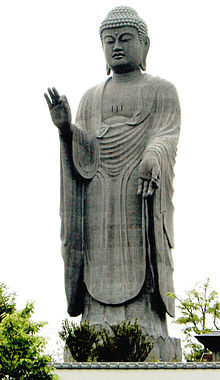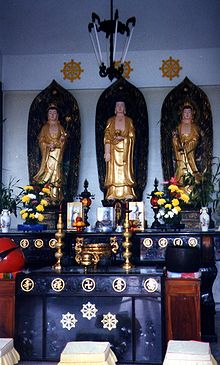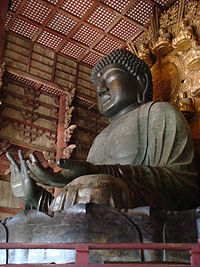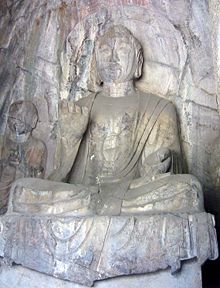- Amitābha
-
This article is about the buddha. For the actor, see Amitabh Bachchan. For other uses, see Amitabha (disambiguation).
Amitabha 
Sanskrit: अमिताभ Amitābha, Amitāyus Chinese: 阿彌陀佛(T) / 阿弥陀佛(S)
Pinyin: Āmítuó FóWade-Giles: A-mi-t’uo Fo
Japanese: 阿弥陀如来 Amida Nyorai Korean: 아미타불 A-mi-ta Bul Mongolian: ᠴᠠᠭᠯᠠᠰᠢ ᠦᠭᠡᠢ ᠭᠡᠷᠡᠯᠲᠦ
Цаглашгүй гэрэлт
Tsaglasi ügei gereltu
Одбагмэд Odbagmed
Аминдаваа Amindavaa
Аюуш AyushTibetan: འོད་དཔག་མེད་
od dpag med
Ö-pa-meVietnamese: A-di-đà Phật Information Venerated by: Mahayana, Vajrayana Attributes: Infinite Light Shakti: Pandara Amitābha (Sanskrit: अमिताभ, Amitābha (wordstem), Hindi pronunciation: [əmɪˈt̪aːbʱə]) is a celestial buddha described in the scriptures of the Mahāyāna school of Buddhism. Amitābha is the principal buddha in the Pure Land sect, a branch of Buddhism practiced mainly in East Asia, while in Vajrayana Amitābha is known for his longevity attribute and the aggregate of distinguishing (recognition) and the deep awareness of individualities. According to these scriptures, Amitābha possesses infinite merits resulting from good deeds over countless past lives as a bodhisattva named Dharmakāra. "Amitābha" is translatable as "Infinite Light," hence Amitābha is often called "The Buddha of Infinite Light."
Contents
Doctrine
According to the Larger Sūtra of Immeasurable Life (Mahāyāna Amitāyus Sūtra) Amitābha was, in very ancient times and possibly in another system of worlds, a monk named Dharmakāra. In some versions of the sūtra, Dharmakāra is described as a former king who, having come into contact with the Buddhist teachings through the buddha Lokesvararaja, renounced his throne. He then resolved to become a buddha and so to come into possession of a buddhakṣetra ("buddha-field", a realm existing in the primordial universe outside of ordinary space time, produced by a buddha's merit) possessed of many perfections. These resolutions were expressed in his forty-eight vows, which set out the type of buddha-field Dharmakāra aspired to create, the conditions under which beings might be born into that world, and what kind of beings they would be when reborn there.
In the versions of the sutra widely known in China, Vietnam, Korea and Japan, Dharmakāra's eighteenth vow was that any being in any universe desiring to be born into Amitābha's Pure Land and calling upon his name even as few as ten times will be guaranteed rebirth there. His nineteenth vow promises that he, together with his bodhisattvas and other blessed Buddhists, will appear before those who call upon him at the moment of death. This openness and acceptance of all kinds of people has made the Pure Land belief one of the major influences in Mahāyāna Buddhism. Pure Land Buddhism seems to have first become popular in northwest India/Pakistan and Afghanistan, from where it spread to Central Asia and China.
The sutra goes on to explain that Amitābha, after accumulating great merit over countless lives, finally achieved buddhahood and is still residing in his land of Sukhāvatī, whose many virtues and joys are described.
The basic doctrines concerning Amitābha and his vows are found in three canonical Mahāyāna texts:
Through his efforts, Amitābha created the "Pure Land" (净土, Chinese: jìngtŭ; Japanese: jōdo; Vietnamese: tịnh độ) called Sukhāvatī (Sanskrit: "possessing happiness") . Sukhāvatī is situated in the uttermost west, beyond the bounds of our own world. By the power of his vows, Amitābha has made it possible for all who call upon him to be reborn into this land, there to undergo instruction by him in the dharma and ultimately become bodhisattvas and buddhas in their turn (the ultimate goal of Mahāyāna Buddhism). From there, these same bodhisattvas and buddhas return to our world to help yet more people.
Amitābha is the Buddha of the comprehensive love. He lives in the west (represented as a meditating Buddha) and works for the enlightenment of all beings (represented as a blessing Buddha). His most important enlightenment technique is the visualization of the surrounding world as a paradise. Who sees his world as a paradise, awakens his enlightenment energy. The world can be seen as a paradise by a corresponding positive thought (enlightenment thought) or by sending light to all beings (wish all beings to be happy). After the Amitabha doctrine, man can come to paradise (in the Pure Land of Amitābha), if he visualizes at his death Amitābha in the heaven (sun) over his head (western horizon), thinks his name as a mantra and leaves the body as a soul through the crown chakra.
Vajrayāna Buddhism
Amitābha is also known in Tibet, Mongolia, and other regions where Tibetan Buddhism is practiced. In the Highest Yoga Tantra class of the Tibetan Vajrayana Amitābha is considered one of the Five Dhyāni Buddhas (together with Akṣobhya, Amoghasiddhi, Ratnasambhava, and Vairocana), who is associated with the western direction and the skandha of saṃjñā, the aggregate of distinguishing (recognition) and the deep awareness of individualities. His consort is Pāṇḍaravāsinī.[1][2][3][4][5] His realm is called either Sukhāvatī (Sanskrit) or Dewachen (Tibetan). His two main disciples (just as the Buddha Shakyamuni had two) are the Bodhisattvas Vajrapani and Avalokiteshvara, the former to his left and the latter to his right. In Tibetan Buddhism, there exists a number of famous prayers for taking rebirth in Sukhāvatī (Dewachen). One of these was written by Je Tsongkhapa on the request of Manjushri,
The Tibetan Panchen Lamas[6] and Shamarpas[7] are considered to be emanations of Amitābha.
He is frequently invoked in Tibet either as Buddha Amitābha – especially in the Phowa practices or as Amitāyus – especially in practices relating to longevity and preventing an untimely death.
In Japanese Vajrayāna, or Shingon Buddhism, Amitābha is seen as one of the thirteen Buddhist deities to whom practitioners can pay homage. Shingon, like Tibetan Buddhism, also uses special devotional mantras for Amitābha, though the mantras used differ. Amitābha is also one of the Buddhas featured in the Womb Realm Mandala used in Shingon practices, and sits to the west, which is where the Pure Land of Amitābha is said to dwell.
Mantras
Amitābha is the center of a number of mantras in Buddhist Vajrayana practices. The Indic form of the mantra of Amitābha is ॐ अमिताभ ह्रीः (Devanagari: oṃ amitābha hrīḥ), which is pronounced in its Tibetan version as Om ami dewa hri (Sanskrit: oṃ amideva hrīḥ). The Japanese Shingon Buddhist mantra is On amirita teizei kara un which represents the underlying Indic form oṃ amṛta-teje hara hūṃ.
In addition to using the mantras listed above, many Buddhist schools invoke Amitābha's name in a practice known as nianfo 念佛 in Chinese and nembutsu in Japanese.
Names in various languages
The proper form (wordstem) of Amitābha's name in Sanskrit is Amitābha, masculine, and the nominative singular is Amitābhaḥ. This is a compound of the Sanskrit words amita ("without bound, infinite") and ābhā ("light, splendor"). Consequently, the name is to be interpreted as "he who possesses light without bound, he whose splendor is infinite".
The name Amitāyus (nominative form Amitāyuḥ) is also used for the Sambhogakāya aspect of Amitabha, particularly associated with longevity.[8] He is mostly depicted sitting and holding in his hands a vessel containing the nectar of immortality. Amitayus is also one of the three deities of long life (Amitayus, White Tara & Ushnishavijaya) . Amitāyus being a compound of amita ("infinite") and āyus ("life"), and so means "he whose life is boundless".
In Chinese, his name is given as Āmítuó Fó (阿彌陀佛), where Āmítuó is the Chinese representation of the first three syllables of either Amitābha or Amitāyus, and Fó is Chinese for Buddha (a very early borrowing of the first syllable of the Sanskrit word).
The name Amitābha is given in Chinese as Wúliàngguāng (無量光; "Infinite Light "), while the name Amitāyus is given as Wúliàngshòu (無量壽; "Infinite Life"). These names are not, however, very commonly used.
In Vietnamese, Korean, and Japanese, the same Chinese characters used for Amitabha are used to represent his name, though they are pronounced slightly differently:
- Vietnamese: A-di-đà Phật
- Korean: Amit'a Bul
- Japanese: Amida Butsu.
In Japanese, he is also called Amida Nyorai (阿弥陀如来), meaning " the Tathāgata Amitābha".
In Tibetan, Amitābha is called 'od.dpag.med and, as Amitāyus, tshe.dpag.med.
Iconography
 This altar display at a temple in Taiwan shows Amitābha in the center, flanked by Mahāsthāmaprāpta on the buddha's right and Guānyīn on the left
This altar display at a temple in Taiwan shows Amitābha in the center, flanked by Mahāsthāmaprāpta on the buddha's right and Guānyīn on the left
It can be difficult to distinguish Amitābha from Śākyamuni (and any buddhas in general) as both are portrayed as possessing all the attributes of a buddha but no distinguishing marks. Amitabha can, however, often be distinguished by his mudrā: Amitābha is often depicted, when shown seated, displaying the meditation mudrā (thumbs touching and fingers together (as in the Kamakura statue of Amitābha) or the exposition mudrā, while the earth-touching mudrā (right hand pointed downward over the right leg, palm inward) is reserved for a seated Śākyamuni alone. He can also be seen holding a lotus in his hands while displaying the meditation mudrā.
When standing, Amitābha is often shown with his left arm bare and extended downward with thumb and forefinger touching, with his right hand facing outward also with thumb and forefinger touching. The meaning of this mudra is that wisdom (symbolized by the raised hand) is accessible to even the lowest beings, while the outstretched hand shows that Amitabha's compassion is directed at the lowest beings, who cannot save themselves.
When not depicted alone, Amitābha is often portrayed with two assistants: Avalokiteśvara who appears on his left and Mahāsthāmaprāpta who appears on his right.
In Vajrayana, Amitābha is the most ancient Buddha among the Dhayni Buddhas. He is of red color originating from the red seed syllable hrih. He represents the cosmic element of "Sanjana" (name). His vehicle is the peacock. He exhibits Samadhi Mudra his two palms folded face up, one on top of the other, lying on his lap. The lotus is his sign. When represented on the stupa, he always faces toward west. He is worshiped thinking that one can have salvation. Sometimes he holds a Patra on the same posture.
Archeological origins
The first known epigraphic evidence for Amitābha is the bottom part of a statue found in Govindnagar, Pakistan and now located at the Mathura Museum. The statue is dated to "the 28th year of the reign of Huviṣka" (i.e., sometime in the latter half of the 2nd century CE, during the period of the Kuṣāṇa Empire), and was apparently dedicated to "Amitābha Buddha" by a family of merchants.
The first known sutra mentioning Amitābha is the translation into Chinese of the Pratyutpanna Sūtra by the Kuṣāṇa monk Lokakṣema around 180 CE. This work is said to be at the origin of Pure Land practice in China.
The appearance of such literature and sculptural remains at the end of the 2nd century suggests that the doctrine of Amitābha probably developed during the 1st and 2nd centuries CE.
See also
Notes
- ^ "The Great Compassion Mantra - Namo Amitabha". Archived from the original on 2009-10-25. http://www.webcitation.org/5knAkPVWw.
- ^ http://kaykeys.net/spirit/buddhism/bardo/4thday.html
- ^ "Symbolism of the five Dhyani Buddhas". http://buddhism.kalachakranet.org/5_dhyani_buddhas.html.
- ^ http://www.himalayanmart.com/pandara.php
- ^ http://www.nationsonline.org/oneworld/Chinese_Customs/Guan_Yin.htm
- ^ Tibet is My Country: Autobiography of Thubten Jigme Norbu, Brother of the Dalai Lama as told to Heinrich Harrer, p. 121. First published in German in 1960. English translation by Edward Fitzgerald, published 1960. Reprint, with updated new chapter, (1986): Wisdom Publications, London. ISBN 0-86171-045-2.
- ^ "Teachers: Shamar Rinpoche". http://www.diamondway.org/whitewater/new-teachers.html. Retrieved 2007-10-21.
- ^ http://www.rigpawiki.org/index.php?title=Amitayus
External links
- Amitabha | facebook
- The Buddha Speaks of Amitabha Sutra (Pure Land)
- Shingon Buddhism: Amida Nyorai/Buddha of Infinite light and Life
- H.H. Chetsang Rinpoche about Amitabha and Dewachen
- French Site : Amitabha Terre Pure
- The Amitabha Sutra
Chinese Buddhist Pantheon Buddhas: Deities:
Deities:Four Heavenly Kings (Sì Tiānwáng) | Sangharama (Qíelán) | Skanda (Wéituó) | Yama (Yán Wáng) | Jìgōng |
Sudhana (Shan Cai) | Nagakanya (Long Nü) | Marici (Mólìzhītiān)Mahākāśyapa | Ānanda | Moggallāna | Bodhidharma (Dámó) | An Shigao | Xuánzàng | Fǎxiǎn | Yìjìng | Shàn Dào | Huìguǒ | Emperor Ming | Emperor Wu | Eighteen LuohansJapanese Buddhist Pantheon  Buddhas (Nyorai-bu):Bodhisattvas (Bosatsu-bu):Vajraparamita (Kongō-Haramitsu) | Vajrasattva (Kongosatta) | Maitreya (Miroku) | Avalokitesvara (Kannon) | Samantabhadra (Fugen) | Manjusri (Monju) | Mahapratisara (Daizuigu) | Ksitigarbha (Jizo) | Akasagarbha (Kokuzo) | Mahasthamaprapta (Seishi)Wisdom Kings (Myōō-bu)Five Wisdom Kings | Acala (Fudo-Myoo) | Rāgarāja (Aizen-Myoo) | Ucchusma (Ususama) | Hayagriva (Bato Kannon) | Mahamayuri (Kujaku-Myoo) | Yamantaka (Daiitoku)Deities (Ten-bu):Shitennō | Marici (Marishi-ten) | Mahakala (Daikokuten) | Saraswati (Benzaiten) | Brahma (Bonten) | Hotei | Jurōjin | Fukurokuju | Vaisravana (Bishamonten) | Ebisu | UgajinIzuna Gongen | Atago Gongen | Konpira DaigongenReligious men (Kōsō・Soshi-bu):Bodhidharma | Prince Shōtoku | Kūkai | Saichō | Dōgen Kigen |Honen | Shinran | Nichiren | Sixteen Arhats
Buddhas (Nyorai-bu):Bodhisattvas (Bosatsu-bu):Vajraparamita (Kongō-Haramitsu) | Vajrasattva (Kongosatta) | Maitreya (Miroku) | Avalokitesvara (Kannon) | Samantabhadra (Fugen) | Manjusri (Monju) | Mahapratisara (Daizuigu) | Ksitigarbha (Jizo) | Akasagarbha (Kokuzo) | Mahasthamaprapta (Seishi)Wisdom Kings (Myōō-bu)Five Wisdom Kings | Acala (Fudo-Myoo) | Rāgarāja (Aizen-Myoo) | Ucchusma (Ususama) | Hayagriva (Bato Kannon) | Mahamayuri (Kujaku-Myoo) | Yamantaka (Daiitoku)Deities (Ten-bu):Shitennō | Marici (Marishi-ten) | Mahakala (Daikokuten) | Saraswati (Benzaiten) | Brahma (Bonten) | Hotei | Jurōjin | Fukurokuju | Vaisravana (Bishamonten) | Ebisu | UgajinIzuna Gongen | Atago Gongen | Konpira DaigongenReligious men (Kōsō・Soshi-bu):Bodhidharma | Prince Shōtoku | Kūkai | Saichō | Dōgen Kigen |Honen | Shinran | Nichiren | Sixteen ArhatsBuddhism Categories:- Buddhas
- Pure Land Buddhism
- Buddhist deities, bodhisattvas, and demons
- Chinese gods
Wikimedia Foundation. 2010.



